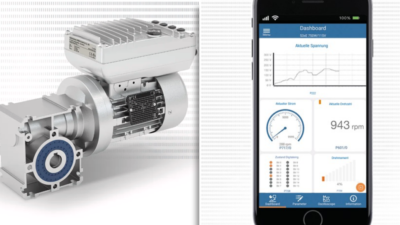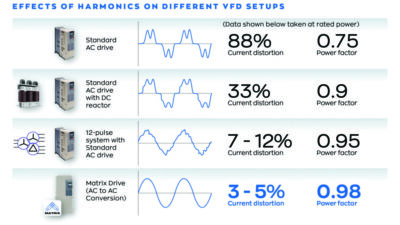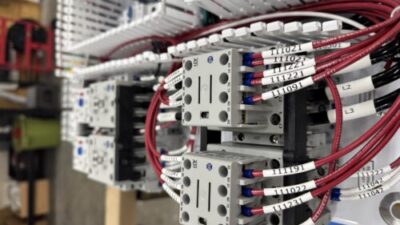Trap filters are a common solution for managing drive harmonics, but matrix drives can provide additional benefits for the user without the need for peripheral equipment and costs.
Due to their control capabilities and efficiency improvements, variable frequency drives (VFDs) are widely used to operate electric motors. However, most conventional drives draw current non-linearly as part of their power conversion process and the resulting distorted current waveform means high harmonics are present. Large amounts of harmonics cause heating in upstream electrical equipment, reduce power factor, lower efficiency, and generate voltage harmonics, which can cause issues with IEEE 519.
A common solution for harmonics is the utilization of an input harmonic filter, also known as a trap filter. These devices “trap” the harmonics to isolate the power supply from the non-linear current draw of the drive. These solutions provide low harmonics, but they come at a cost. Whenever equipment is added to a system, additional costs are accrued, additional space is needed, and efficiency drops. An alternative to trap filters is matrix drive technology, which provides a compact solution for low harmonics without the need for additional peripheral equipment.
Testing harmonics
Low input current harmonic performance is one of the key advantages of using matrix technology for power conversion. While operating the motor, current is drawn from the line naturally with low harmonic levels. Matrix drives typically operate with less than 5% total harmonic distortion (THD) at the drive’s input. Input filters mitigate the harmonics a conventional drive produces. Input harmonic filters maintain low harmonics at rated load and light loads. However, the matrix drive maintains lower harmonics than a drive with a trap filter throughout the entire load profile.
Testing efficiency
The matrix drive is compact and designed to provide low input current harmonics with drive efficiency near 98%. Its efficient operation is maintained throughout the operating range. Harmonic filters mean extra equipment and wiring to maintain low harmonics. The result is lower efficiency at rated power and throughout the load range as compared to matrix drives.
Testing reactive power
In addition to lower efficiency, input harmonic filters require large amounts of capacitance to maintain low harmonic current performance. High amounts of capacitance mean higher reactive currents, which circulate between the line and the filter to generate additional losses and reduce system efficiency. Moreover, utility companies are beginning to place demand charges on total power (kVA) usage. High amounts of reactive power will inflate the kVA, resulting in higher utility bills than the real power (kW) demand requires.
The matrix design includes a small input filter to isolate the source from the drive’s ac-to-ac power output and to convert the regenerative waveform back into a clean sinewave to save potentially wasted energy. Because the matrix drive naturally draws low harmonic current from the source as it operates the motor, there is no need for a harmonic trap filter.
Regeneration
The matrix drive uses bi-directional insulated-gate bipolar transistor (IGBTs) switches to directly connect ac input power to ac output power. Another important benefit of this selective direct connection of input voltage to output voltage is regenerative energy can automatically be put back onto the line. When this takes place, voltage is usually redirected to other loads on the same source, which means less power is drawn from the utility, thus lowering the utility power draw and the utility bill.
Input trap filters only mitigate input current harmonics, but have no capability for regeneration. For regeneration with a trap filter, even more additional components would be required for dissipating or regenerating energy produced by the application, without which unwanted drive faults (overvoltage faults) are likely to occur during motor operation. These challenges stemming from regenerative energy are eliminated using matrix drive technology.
Complexity
Full power motoring and regeneration with low harmonic performance is provided in the matrix drive’s compact, all-in-one package. A simple three-wires-in and three-wires-out is all that is needed for its power wiring. Trap filters require additional wiring for the several pieces of equipment that make up these filters, all of which need to be mounted in a protective enclosure or inside a larger panel. The wiring and equipment for the filter is in addition to the wiring and panel requirements of the drive needed to operate the motor.
Tripless (no fault) operation
The construction of the input harmonic filter requires a large amount of capacitance to maintain low harmonics. This large capacitance means higher reactive currents and higher kVA requirements, which again reduce efficiency and increase operational cost. These filters also act as a voltage boosting circuit. When the drive is not operating the motor or is operating under light loads the input filter circuit will boost the line voltage to raise the drive’s dc bus voltage, which can cause an overvoltage condition. This condition can cause nuisance faults or even prevent operation.
The only method of overcoming the effects of the voltage boost is to add more equipment. A contactor would need to be added to isolate the capacitor during idle and low speed operation. Again, added equipment means added costs and the system efficiency and reliability reduces. The addition of a contactor may resolve the high dc bus level and overvoltage trips on the drive, but utilizing the contactor also prevents low harmonic operation at light loads. The matrix drive provides tripless operation without additional equipment and maintains its low harmonic performance throughout the speed range.
Trap filters might be an economical means of managing drive harmonics; however, the harmonic benefits of these filters come with a downside. Trap filters add cost, require additional equipment, mounting space, install time, wiring, and reduce efficiency and reliability. Conversely, matrix drive technology naturally draws low harmonic current as it operates the motor. The technology allows for a compact, all-in-one package that enables motor regeneration, making the matrix drive an efficient low harmonic and regenerative drive in the market for installation, start-up, and operation.
Christopher Jaszczolt, product manager, Yaskawa America Inc. Edited by Chris Vavra, production editor, Control Engineering, CFE Media, [email protected].
MORE ANSWERS
Keywords: Drive harmonics, matrix drives, trap filters
- Trap filter isolate the power supply from the non-linear current draw of the drive to provide low harmonics, but they aren’t as cost-effective.
- Matrix drive technology provides a compact solution for low harmonics without the need for additional peripheral equipment.
- Matrix drives are a cost-efficient and compact low harmonic and regenerative drive that has lower energy costs and fewer required parts than a trap filter.
Consider this
What applications would benefit most from a matrix drive?



